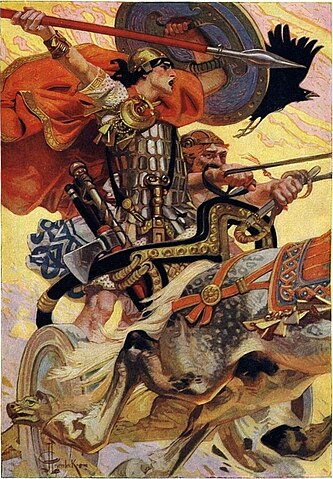The Birth of Cú Chulainn: Irish Mythology
Cú Chulainn, one of Ireland’s most celebrated heroes, lived a life steeped in prophecy, mystery, and divine intervention.
His birth story is as legendary as the feats he accomplished in adulthood. Here’s the detailed tale of how this hero came into the world.
Table of Contents
The Prophecy and the Land of Emain Macha
The story begins in the court of Conchobar mac Nessa, king of Ulster, who ruled from his fortress at Emain Macha (modern-day Navan Fort in County Armagh).
One day, Deichtine, Conchobar’s sister, and his charioteer set out on a journey with others from the court. A sudden snowstorm forced them to seek shelter in a mysterious house that seemed to appear out of nowhere.
Inside, they were greeted by a man who welcomed them warmly. The man’s wife was in labour, and the Ulstermen assisted in delivering a baby boy.
As a gesture of gratitude, the couple asked Deichtine to nurse and raise the child. She agreed, but the house and the couple vanished the next morning.
The baby was gone, and Deichtine found herself mysteriously pregnant.
The God Lugh Intervenes

In a vision, Deichtine learned that the great god Lugh of the Tuatha Dé Danann, a deity associated with kingship, arts, and battle, had visited her in the form of a bird and caused her pregnancy.
Lugh revealed that the child she carried was destined to be a great hero who would protect Ulster and achieve legendary status.
Deichtine returned to Emain Macha, where her unexplained pregnancy caused a scandal. Conchobar arranged her marriage to Sualtam mac Róich, a nobleman, to maintain her honour.
Some versions of the tale suggest that Deichtine terminated the divine pregnancy during this time. However, shortly after her marriage to Sualtam, she conceived again, giving birth to a boy who would later be named Setanta.
The Naming of Setanta
As a child, Setanta displayed exceptional strength, intelligence, and charisma. Raised in the court of Conchobar, he grew up surrounded by warriors and tales of heroism. It was clear from an early age that he was destined for greatness.
When he was just a boy, Setanta begged to join the elite group of warriors who trained at Conchobar’s court. Though initially deemed too young, his determination and potential earned him a place among them. Read the story of the knighting of Setanta for more information.
The Story of Cú Chulainn

Setanta’s most famous childhood story explains how he acquired the name Cú Chulainn, meaning “the Hound of Chulainn.”
One evening, Setanta was invited to a feast at the home of the blacksmith Culann. He arrived late because he was playing a game of hurling. Culann, unaware of his tardiness, released his ferocious guard dog to protect the estate.
When the hound attacked, Setanta killed it single-handedly, using only his hurley and sliotar (hurling stick and ball).
Culann was devastated at the loss of his prized protector. To make amends, Setanta offered to take the hound’s place until a replacement could be raised and trained. From that day on, he was known as Cú Chulainn—Culann’s Hound.
The Prophecy of Glory and Short Life

Cú Chulainn’s destiny was intertwined with a prophecy made at his birth. A druid foretold that he would achieve eternal fame, but his life would be short and filled with strife.
This prophecy shaped his choices and actions throughout his life, as he embraced his fate with bravery and determination.
The Early Signs of a Hero
Even as a boy, Cú Chulainn showed signs of his extraordinary abilities. He was said to enter a battle frenzy known as the ríastrad or “warp-spasm,” transforming into an unstoppable force of destruction. His youthful feats included:
- Slaying wild animals.
- Defeating warriors many times his age.
- Protecting Ulster single-handedly when its warriors were incapacitated by a curse.
Conclusion
The birth and early life of Cú Chulainn set the stage for his legendary exploits as a warrior of Ulster.
Born of both mortal and divine lineage, his life was shaped by prophecy, divine intervention, and an unyielding drive to fulfil his destiny.
This tale, rich with myth and symbolism, continues to captivate audiences and is one of the most iconic stories in Irish mythology.
